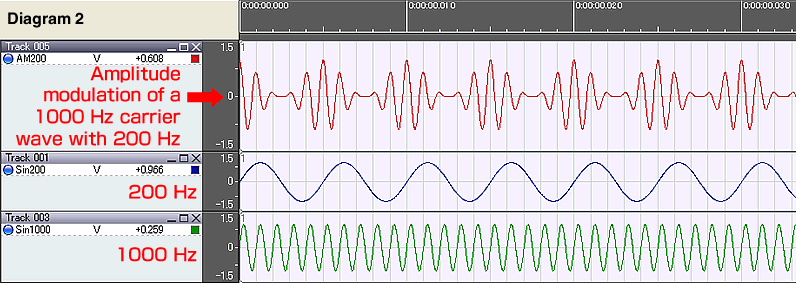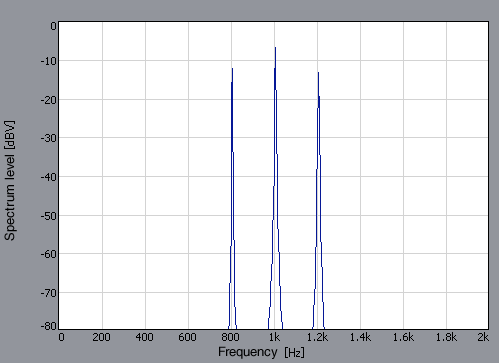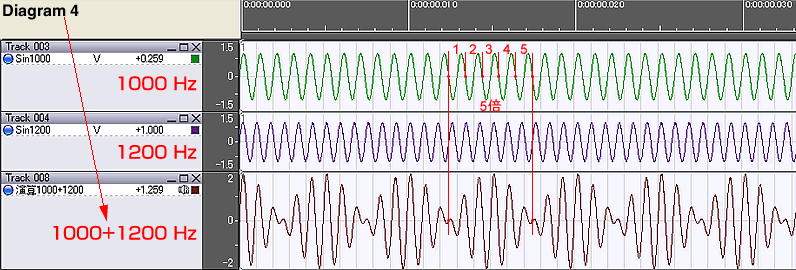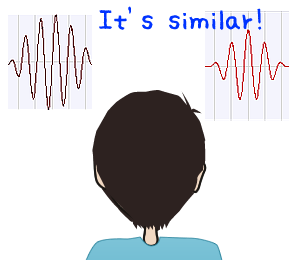- HOME
- Ono Sokki's Patio
- Difference Tone

Difference Tone
Ken: You taught me the other day about the beats. When two slightly different frequencies overlap, beats are created. But what happens when the frequency difference becomes greater?
Dad: Frequency difference is the cycle of beats. And the example we used before is 205 Hz and 200 Hz, so the fluctuating frequency is 5 Hz. This is a sound that becomes larger and smaller alternately for 5 times in 1 second. You know, when the frequency difference of two sounds becomes greater, the cycle becomes shorter.
Ken: I know that. I think I can hear the beats of several times per second, but I wondered what it's like when there is tens of Hz of frequency difference, which means it's going to fluctuate 10s of times in a second.
Dad: Well, you remembered the fluctuating sound I told you when we talked about the "Nakiryu". Let's listen to the "sound with its fluctuation frequency changing from 1 Hz to 200 Hz." once more.
If you listen closely, from the fluctuation frequency of around 30 Hz, you can tell the sound gradually becomes low. For example, if you compare the sounds with fluctuation frequencies of 4 Hz and 200 Hz, you can hear the difference of the sound pitch.
Ken: Indeed, I didn't notice at the time since I was paying attention to the roughness of the sound. But when you compare these two sounds, their pitches are different. What does this mean?
Dad: It's a little difficult but I'll explain. If a carrier wave of 1000 Hz is amplitude-modulated with 200 Hz wave, it shows these diagrams of
 time (Diagram 2) (Roll cursor over here for picture)
time (Diagram 2) (Roll cursor over here for picture)
and
 frequency (Diagram 3) (Roll cursor over here for picture).
frequency (Diagram 3) (Roll cursor over here for picture).
This is the graph of the sound you just heard, with fluctuation frequency of 200 Hz. You can see the sound components of 1200 Hz and 800 Hz, that are 200 Hz higher and lower from the carrier wave of 1000 Hz.
Ken: I wonder why the 200 Hz wave is sounded lower when I compared the sounds with fluctuation frequencies of 4 Hz and 200 Hz, although both are from the same 1000 Hz wave ...
Dad: The auditory sense of human is basically made to capture a cycle. Sound pitch is nothing but a cycle. But when it comes close to the lower limit of the audio frequency and the cycle becomes longer, you hear it as a pattern with a rhythm instead of the sound pitch.
Ken: The beat is that pattern too. People can't hear a pitch of a 4 Hz sound, instead you hear the pattern of 4 Hz by the original sound waveform of 1000 Hz. But this doesn't relate to the fact that the sound with fluctuation frequency of 200 Hz sounds lower than that of 4 Hz, does it?
Dad: It's awhile back, but do you remember when I talked about frequency masking?
Ken: Somewhat. If two sounds have similar frequencies, one sound masks the other.
Dad: Yes. The lower sound masks the higher sound.
Ken: I've got it. Of the sounds shown on the graph, the 1000 Hz sound masked the 1200 Hz sound but the 800 Hz sound was not masked so I heard a sound lower than the 1000 Hz.
Dad: Correct! If the frequency difference is within the critical band width (bandwidth where auditory sense can separate sound pitch), masking occurs. In this case, it's barely within the range so a masking effect is taking place.
Ken: You said the sound is gradually decreasing from the fluctuation frequency of 30 Hz. It's because people hear the peak of the frequency which is lower than 1000 Hz by its fluctuation frequency, and as the fluctuation frequency becomes larger, the difference becomes larger in lowering direction.
Dad: Exactly. In fact, the overlapping of the two sounds with large difference in frequency you asked first shows roughly the same waveform as the amplitude modulation.
 This diagram (Diagram 4) (Roll cursor over here for picture)
This diagram (Diagram 4) (Roll cursor over here for picture)
is the overlapping of the 1000 Hz and 1200 Hz sound waveforms.
Ken: It's a similar shape.
Dad: There is another interesting phenomenon with the overlapping of two sounds. If you observe this waveform regarding the cycle that repeats the same shape, how many times bigger than the 1000 Hz waveform?
Ken: 5 times! I see, the difference between 1000 Hz and 1200 Hz, or 200 Hz is the cycle of this waveform with the same shape.
Dad: Exactly. And you hear this difference of 200 Hz as a sound. Earlier, I said that the auditory sense of human basically captures cycles, and the cycle means the sound pitch. For the beat of sound, frequency difference is the pattern of time variation but when the difference of frequency widens, you hear the sound of that frequency difference.
Ken: I see. If you listen carefully, you can hear the low sound.
Click here for sound. Be careful with the volume.
Listen the sound (1000 Hz + 1200 Hz).
Listen the sound (1000 Hz).
Listen the sound (1200 Hz).
Listen the sound (200 Hz).
Dad: There are other interesting stories about the difference tone. So I will tell you another time.
- © ONO SOKKI CO., LTD. 1996-2025
